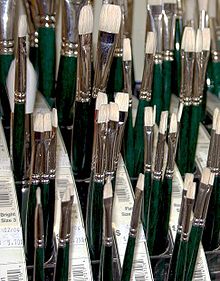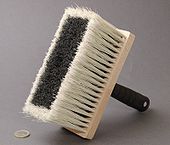brush
A brush is a tool used to apply liquids, such as ink or paint . In digital image processing (e.g. digital painting or Photoshop , GIMP, etc.) one also speaks of brushes with which one draws on the screen . Brushes are also used for hair care and cosmetics . Glass fiber brush and some other types of brushes are used for cleaning surfaces.
Manufacturing
Brushes are either made by machine in the industry or still by hand by brush makers . The latter applies in particular to brushes that have to meet special requirements, such as in porcelain painting . Johann Caspar Bühler is considered to be the founder of the German fine-hair brush trade . He entered the parish register of Königshofen , today a district of Markt Bechhofen, as a master carpenter and brush maker around 1790 . Fine-hair brushes from Bechhofen have been on the world market since the middle of the 19th century. Even today there is a state vocational school for the brush making trade and the German Brush and Brush Museum .
When making brushes by hand, the brush maker takes a suitable amount of animal or synthetic hair or bristles, cut to the correct length, depending on the size of the brush, and inserts it into a suitable metal cylinder closed on the bottom, which he taps on the work table until all hairs or bristles touch the ground. The tuft is removed from the cylinder and put into a thread loop. By tightening the loop and twisting the tuft between the fingers, the brush maker can make the tuft form a point. The tuft is tightly wrapped with another loop of thread and then inserted into the ferrule with which the tuft is later attached to the brush handle. The ferrule is a suitably shaped, often cylindrical or conical metal sleeve - also called a ferrule - into which the tuft must fit exactly. The tuft is glued to the ferrule with an adhesive inside. Finally, the clamp is pushed onto the handle and, if necessary, pressed with it.
to form
Painting brushes consist of three parts: the hair, the handle and the ferrule that connects the handle and hair. Brushes can have three shapes:
- Round: Due to the long, closely spaced bristles, these brushes (round brushes) can hold more paint than other shapes. Therefore, they are preferred for large areas. Turning the brush enables an even application of paint.
- Flat: Flat brushes (flat brushes) distribute the color well and can be used “across” well for relatively narrow lines and corners.
- Fan-shaped: Fan-shaped brushes (fan brushes) can mix paint very well.
- Properties: The coarser the shape of the hair, the more color it can absorb.
- Special brush
- Pickling brushes are suitable for pickling . These are particularly high-quality, non-shedding brushes. Because stain reacts with metal, stain brushes should be metal-free. Stain attacks hair and bristles, which is why plastic fibers are mainly used as trimming material.
- Writing brushes are used in East Asian calligraphy .
- A quast is a wide brush with a dense, soft layer of bristles that is suitable for applying paint over a large area, for example as a so-called "white brush" for whitening (painting white) or wetting (as preparation for masonry) walls and for pasting wallpaper or Posters. Depending on the region, it is also referred to as a ceiling brush. In the construction sector, brushes with hard bristles are also used, for example, to apply bitumen or tar seals.
- A book brush is used to remove dust from books.
- A radiator brush is a cranked brush for painting corners and angles. Mostly used in the past to paint radiators, as other painting tools could hardly get between the radiator ribs.
- Brush from sable be used in water color painting, where brush made of squirrel hair come (squirrel hair) for use.
- Pointers are used for gilding work.
maintenance
Brushes should be cleaned immediately after use. This is particularly true with acrylic paint or oil paint , as these can hardly be removed when dry and bristles can be torn out or the shape of the brush can be destroyed. Water-soluble paints such as acrylic paints can be washed out with water as long as they have not dried up. For cleaning oil paint brushes, turpentine or moisturizing artist soap is used. After cleaning, the brush is trained, i. H. brought to its original shape and dried.
Cosmetic brushes should be cleaned regularly with lukewarm water and a suitable soap-based cleaner in order to avoid excessive contamination with germs.
Brushes should not be left with the bristles facing down in water , turpentine or other solvents for long periods of time . The bristles are pressed against the bottom of the vessel and the brush loses its shape.
See also
- brush
- Chinese brush technique
- Drip painting
- Hair brush
- Japanese brush technique
- Brush drawing
- Shaving brush
literature
- Cennino Cennini da Colle di Val d'Elsa: Libro dell'arte o trattato della pittura . The book of art translated by Albert Ilg . Braumüller, Vienna 1871, pp. 40–43.
- Ernst Bock: Brushes and Paintbrushes; The diverse products of the brush and paintbrush making trade and their most important components . Bechhofen, Berlin 1983.





